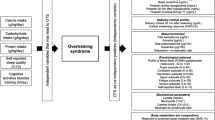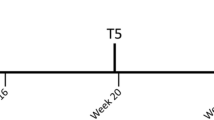Abstract
Purpose
Overtraining syndrome (OTS) is reported in endurance sports. Thyroid hormones (TH) regulate metabolism, mood, and energy production, and may play a role in OTS of endurance athletes. The purpose of this study was to investigate relationships in TH and symptoms of OTS in track and field endurance runners (ER).
Methods
Sixteen female track and field middle distance (MD; n = 9; age: 20.2 ± 1.5 years; ht: 167.86 ± 5.04 cm; body-mass: 57.97 ± 5.05 kg; VO2MAX: 53.62 ± 6.04 ml/kg/min) and long distance (LD; n = 7; age: 20.5 ± 1.5 years; ht: 162.48 ± 6.11 cm; body-mass: 56.15 ± 5.99 kg; VO2MAX: 61.94 ± 3.29 ml/kg/min) ER participated in this descriptive study (15-weeks). Thyroid-stimulating hormone (TSH), triiodothyronine (T 3), and thyroxine (T 4), were collected at pre-(PRE) and post-season (POST). A fatigue scale was administered weekly, and percent change (PΔ) in race time (season best vs. championship performance) was calculated. Wilcoxon-sign ranked tests and Spearman’s rho correlations were used to determine changes and relationships between TH and performance.
Results
TSH, T 3 and T 4 did not change from PRE to POST. The percent change (PΔ) in T 3 from PRE to POST was correlated with running performance at the end of the season (ρ = − 0.70, p = 0.036). Fatigue at week 12 correlated with running performance at the end of the season (ρ = − 0.74, p = 0.004).
Conclusion
TH may be valuable in assessing the overall training state of ER. TH concentrations change too slowly to be a frequent marker of monitoring OTS, but are related to markers of decreased performance. Monitoring dietary intake, and fatigue may be predictive markers to assess OTS and training status of female ER.





Similar content being viewed by others
Abbreviations
- CHO:
-
Carbohydrate
- ELISA:
-
Enzyme-linked immunosorbent assay
- ER:
-
Endurance runners
- kcals:
-
Total calorie consumption
- LD:
-
Long distance
- MD:
-
Middle distance
- OTS:
-
Overtraining syndrome
- PΔ:
-
Percent delta change
- PRE:
-
Preseason
- POST:
-
Post-season
- PRO:
-
Protein
- T 3 :
-
Triiodothyronine
- T 4 :
-
Thyroxine
- TH:
-
Thyroid hormones
- TSH:
-
Thyroid stimulating hormone
References
Baylor LS, Hackney AC (2003) Resting thyroid and leptin hormone changes in women following intense, prolonged exercise training. Eur J Appl Physiol 88:480–484
Boyden TW, Pamenter RW, Stanforth P, Rotkis T, Wilmore JH (1982) Evidence for mild thyroidal impairment in women undergoing endurance training. J Clin Endocrinol Metab 54:53–56
Boyden TW, Pamenter RW, Rotkis TC, StanforthH P, Wilmore JH (1984) Thyroidal changes associated with endurance training in women. Med Sci Sport Exerc 16:243–246
Cheng SY, Leonard JL, Davis PJ (2010) Molecular aspects of thyroid hormone actions. Endocr Rev 31:139–170
Cioffi F, Senese R, Lanni A, Goglia F (2013) Thyroid hormones and mitochondria: with a brief look at derivatives and analogues. Mol Cell Endocrinol 379:51–61
Dunn ME, Hennessey JV, Cosmas AC, Lamont LS, Manfredi TG (2009) Clinical case report : ultrastructural evidence of skeletal muscle mitochondrial dysfunction in patients with subclinical hypothyroidism. Thyroid Sci 4:1–8
Fry RW, Morton AR, Garcia-Webb P, Crawford GP, Keast D (1992) Biological responses to overload training in endurance sports. Eur J Appl Physiol Occup Physiol 64:335–344
Fry RW, Grove JR, Morton AR, Zeroni PM, Gaudieri S, Keast D (1994) Psychological and immunological correlates of acute overtraining. Br J Sports Med 28:241–246
Gold MS, Pottash AL, Extein I Hypothyroidism and depression (1981) Evidence from complete thyroid function evaluation. JAMA 245:1919–1922
Halson SL, Lancaster GI, Achten J, Gleeson M, Jeukendrup AE (2004) Effects of carbohydrate supplementation on performance and carbohydrate oxidation after intensified cycling training. J Appl Physiol 97:1245–1253
Harber VJ, Peterson SR, Chillibeck PD (1998) Thyroid hormone concentrations and muscle metabolisim in amenorreic and eumenorrheic athletes. Can J Appl Physiol 23:293–306
Heemstra KA, Soeters MR, Fliers E, Serlie MJ, Burggraaf J, van Doorn MB, van der Klaauw AA, Romijn JA, Smit JW, Corssmit EP, Visser TJ (2009) Type 2 iodothyronine deiodinase in skeletal muscle: effects of hypothyroidism and fasting. J Clin Endocrinol Metab 94:2144–2150
Hohtari H, Pakarinen A, Kauppila A (1987) Serum concentrations of thyrotropin, thyroxine, triiodothyronine and thyroxine binding globulin in female endurance runners and joggers. Acta Endocrinol (Copenh) 114:41–46
Larsen PR (2009) Type 2 iodothyronine deiodinase in human skeletal muscle: new insights into its physiological role and regulation. J Clin Endocrinol Metab 94:1893–1895
Larsen PR, Davies TF, Schlumberger MJ, Hay ID (2003) Thyroid physiology and diagnostic evaluation of patients with thyroid disorders. In: Larsen PR, Kronenberg HM, Melmed S, Polonsky KS (eds) Williams textbook of endocrinology. Saunders, Philadelphia, pp 331–373
Lehmann M, Gastmann U, Petersen KG, Bachl N, Seidel A, Khalaf AN, Fischer S, Keul J (1992) Training—overtraining: performance, and hormone levels, after a defined increase in training volume versus intensity in experienced middle- and long-distance runners. Br J Sports Med 26:233–242
Loucks AB, Callister R (1993) Induction and prevention of low-T3 syndrome in exercising women. Am J Physiol 264:R924–R930
Loucks AB, Heath EM (1994) Induction of low-T3 syndrome in exercising women occurs at a threshold of energy availability. Am J Physiol 266:R817–R823
Loucks AB, Laughlin GA, Mortola JF, Girton L, Nelson JC, Yen SS (1992) Hypothalamic-pituitary-thyroidal function in eumenorrheic and amenorrheic athletes. J Clin Endocrinol Metab 75:514–518
Lucía A, Hoyos J, Pérez M, Chicharro JL (2001) Thyroid hormones may influence the slow component of VO2 in professional cyclists. Jpn J Physiol 51:239–242
Luden N, Hayes E, Galpin A, Minchev K, Jemiolo B, Raue U, Trappe TA, Harber MP, Bowers T, Trappe S (2010) Myocellular basis for tapering in competitive distance runners. J Appl Physiol 108:1501–1509
Maia AL, Kim BW, Huang SA, Harney JW, Larsen PR (2005) Type 2 iodothyronine deiodinase is the major source of plasma T3 in euthyroid humans. J Clin Investig 115:2524–2533
Meeusen R, Duclos M, Foster C, Fry A, Gleeson M, Nieman D, Raglin J, Rietjens G, Steinacker J, Urhausen A (2013) European College of Sport Science; American College of Sports Medicine. Prevention, diagnosis, and treatment of the overtraining syndrome: joint consensus statement of the European College of Sport Science and the American College of Sports Medicine. Med Sci Sports Exerc 45:186–205
Pasquali R, Parenti M, Mattioli L, Capelli M, Cavazzini G, Baraldi G, Sorrenti G, De Benedettis G, Biso P, Melchionda N (1982) Effect of dietary carbohydrates during hypocaloric treatment of obesity on peripheral thyroid hormone metabolism. J Endocrinol Investig 5:47–52
Purvis D, Gonsalves S, Deuster PA (2010) Physiological and psychological fatigue in extreme conditions: overtraining and elite athletes. PM R 2:442–450
Rossmeis JH, Duncan RB, Inzana KD, Panciera DL, Shelton GD (2009) Longitudinal study of the effects of chronic hypothyroidism on skeletal muscle in dogs. Am J Vet Res 70:879
Steinacker JM, Brkic M, Simsch C, Nething K, Kresz A, Prokopchuk O, Liu Y (2005) Thyroid hormones, cytokines, physical training and metabolic control. Horm Metab Res 37:538–544
Tornberg AB, Melin A, Manderson Koivula F, Johansson A, Skouby S, Faber J, Sjödin A (2017) Reduced neuromuscular performance in amenorrheic elite endurance athletes. Med Sci Sports Exerc. doi:10.1249/MSS.0000000000001383
Warner A, Mittag J (2012) Thyroid hormone and the central control of homeostasis. J Mol Endocrinol 49:R29–R35
Werneck FZ, Coelho EF, de Lima JR, Laterza MC, Barral MM, Teixeira Pde F, Vaisman M (2014) Pulmonary oxygen uptake kinetics during exercise in subclinical hypothyroidism. Thyroid 24:931–938
Acknowledgements
We would like to thank the athletes and coaches of the women’s track and field team for assistance and participation in the completion of this investigation.
Author information
Authors and Affiliations
Corresponding author
Additional information
Communicated by Fabio Fischetti.
Rights and permissions
About this article
Cite this article
Nicoll, J.X., Hatfield, D.L., Melanson, K.J. et al. Thyroid hormones and commonly cited symptoms of overtraining in collegiate female endurance runners. Eur J Appl Physiol 118, 65–73 (2018). https://doi.org/10.1007/s00421-017-3723-9
Received:
Accepted:
Published:
Issue Date:
DOI: https://doi.org/10.1007/s00421-017-3723-9




